- STATISTICAL RELEASE
Euro area quarterly balance of payments and international investment position:
fourth quarter of 2020
9 April 2021
- Current account surplus at €250 billion (2.2% of euro area GDP) in 2020, down from €280 billion (2.3% of GDP) in 2019
- Geographic counterparts: largest bilateral surpluses vis-à-vis United Kingdom (€151 billion) and United States (€79 billion), with largest deficits vis-à-vis offshore centres (€94 billion) and China (€79 billion)
- International investment position showed net assets of €91 billion (around 0.8% of euro area GDP) at end of 2020
Current account
The current account surplus of the euro area declined to €250 billion (2.2% of euro area GDP) in 2020, from €280 billion (2.3% of GDP) in 2019 (see Table 1). This decrease reflected a reduction in the surpluses for services (from €60 billion to €31 billion) and primary income (from €50 billion to €41 billion), and a larger deficit for secondary income, which increased from €152 billion to €162 billion. These developments were partly offset by an increase in the surplus for goods (from €323 billion to €340 billion).
The smaller surplus for services was mainly due to a decline in the surpluses for travel services (from €42 billion to €8 billion) and transport services (from €20 billion to €10 billion) and a larger deficit for other services (up from €9 billion to €30 billion). These developments were partly offset by a decline in the deficit for other business services (from €102 billion to €69 billion) and an increase in the surplus for telecommunication, computer and information services (from €94 billion to €102 billion).
The decrease in the primary income surplus was due to a fall in the surplus for investment income (from €22 billion to €9 billion). This reflected mainly a lower surplus for direct investment income (down from €84 billion to €27 billion), which was partly offset by a smaller deficit for portfolio equity income (down from €112 billion to €73 billion) and a larger surplus for portfolio debt income (up from €35 billion to €41 billion).
Table 1
Current account of the euro area
(EUR billions, unless otherwise indicated; transactions during the period; non-working day and non-seasonally adjusted)
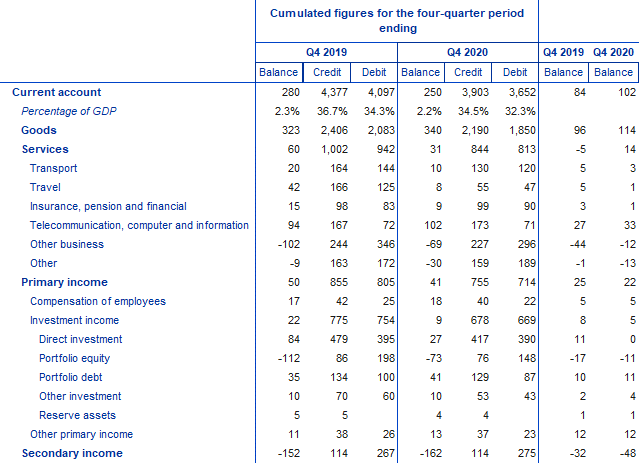
Source: ECB.
Notes: “Equity” comprises equity and investment fund shares. Discrepancies between totals and their components may arise from rounding.
Data on the geographic counterparts of the euro area current account (see Chart 1) show that in 2020 the euro area recorded its largest bilateral surpluses vis-à-vis the United Kingdom (€151 billion, down from €197 billion in 2019), the United States (€79 billion, down from €107 billion) and Switzerland (€54 billion, down from €65 billion). It also recorded a current account surplus vis-à-vis a residual group of other countries (€187 billion, up from €128 billion). The largest bilateral deficits were recorded vis-à-vis offshore centres (€94 billion, down from €115 billion) and China (€79 billion, up from €65 billion).
The most significant geographic changes in 2020 relative to 2019 were as follows. In the goods balance there were decreases in the surpluses vis-à-vis offshore centres (from €48 billion to €30 billion) and the United Kingdom (from €111 billion to €97 billion) and an increase in the deficit vis-à-vis China (from €80 billion to €93 billion). Moreover, the goods surplus vis-à-vis the residual group of other countries increased strongly (from €7 billion to €82 billion), partly reflecting a decline in the deficit vis-à-vis Russia (from €33 billion to €4 billion).
In services the deficit vis-à-vis the United States increased (from €19 billion to €78 billion), while the deficit vis-à-vis offshore centres declined (from €111 billion to €58 billion). The surplus vis-à-vis the United Kingdom decreased (from €47 billion to €26 billion). In primary income, a lower deficit was recorded vis-à-vis the United States (down from €43 billion to €7 billion), while the deficit vis-à-vis offshore centres increased (from €50 billion to €66 billion). In secondary income, the deficit vis-à-vis the EU Member States and EU institutions outside the euro area widened slightly from €91 billion to €96 billion.
Chart 1
Geographical breakdown of the euro area current account balance
(four-quarter moving sums in EUR billions; non-seasonally adjusted)
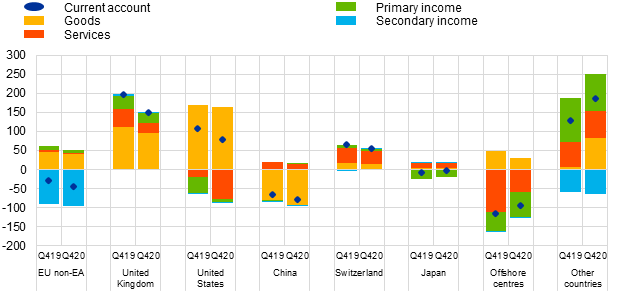
Source: ECB.
Note: “EU non-EA” comprises EU Member States and EU institutions outside the euro area. “Other countries” includes all countries and country groups not shown in the chart, as well as unallocated transactions.
International investment position
At the end of 2020 the international investment position of the euro area recorded net assets of €91 billion vis-à-vis the rest of the world (0.8% of euro area GDP), compared with net assets of €61 billion in the previous quarter (see Chart 2 and Table 2).
Chart 2Net international investment position of the euro area
(net amounts outstanding at the end of the period as a percentage of four-quarter moving sums of GDP)

Source: ECB.
This improvement of €30 billion reflected large but partly offsetting changes in the various investment components. Larger net assets were recorded for portfolio debt (€885 billion, up from €435 billion), while net assets declined in direct investment (€1,773 billion, down from €1,848 billion). Larger net liabilities were recorded for other investment (€874 billion, up from €568 billion) and portfolio equity (€2,486 billion, up from €2,467 billion).
Table 2
International investment position of the euro area
(EUR billions, unless otherwise indicated; amounts outstanding at the end of the period, flows during the period; non-working day and non-seasonally adjusted)
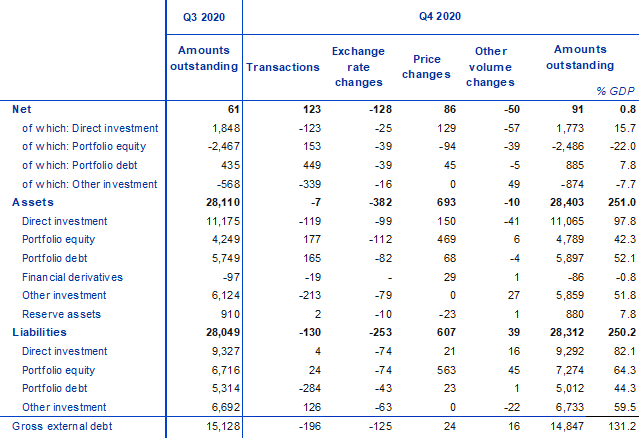
Source: ECB.
Notes: “Equity” comprises equity and investment fund shares. Net financial derivatives are reported under assets. Discrepancies between totals and their components may arise from rounding.
The change in the euro area’s net international investment position in the fourth quarter of 2020 was driven by positive net flows due to transactions and price changes, which were partly offset by negative net exchange rate changes and other volume changes (see Chart 3).
Both the increase in net assets for portfolio debt and the increase in net liabilities for other investment were largely driven by transactions (see Table 2). Larger net liabilities for portfolio equity resulted from a combination of negative net price changes, exchange rate changes and other volume changes, which were partly offset by positive transactions. The decrease in net assets for direct investment was due to negative net flows in transactions, other volume changes and exchange rate changes, which were partly offset by positive net price changes.
At the end of 2020 the gross external debt of the euro area amounted to €14.8 trillion (around 131% of euro area GDP), down by €281 billion compared with the previous quarter.
Chart 3
Changes in the net international investment position of the euro area
(EUR billions; flows during the period)
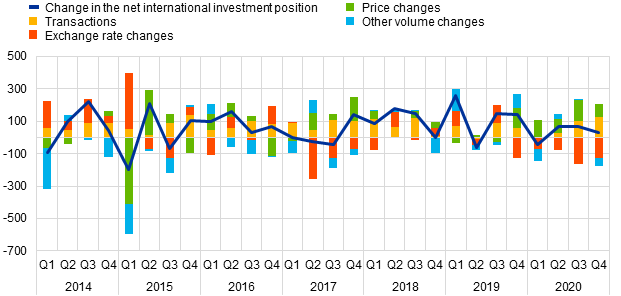
Source: ECB.
Note: “Other volume changes” mainly reflect reclassifications and data enhancements.
At the end of 2020 the stock of euro area direct investment assets was €11.1 trillion, 24% of which was invested in the United States and 20% in the United Kingdom (see Table 3). The stock of foreign direct investment liabilities was €9.3 trillion, with 28% being investments by the United States, 21% by offshore centres and 18% by the United Kingdom.
In portfolio investment, euro area holdings of foreign securities amounted to €4.8 trillion in equity and to €5.9 trillion in debt at the end of 2020. The largest holdings of equity securities by the euro area were from the United States (accounting for 47%), followed by offshore centres and the United Kingdom (11% and 10% respectively). For debt securities, the largest holdings by the euro area were from the United States (accounting for 34%), the United Kingdom (21%) and the EU Member States and EU institutions outside the euro area (14%). On the portfolio investment liabilities side, non-residents’ holdings of securities issued by euro area residents stood at €7.3 trillion in equity and at €5.0 trillion in debt at the end of 2020. The largest holder countries of euro area equity securities were the United States (43%) and the United Kingdom (9%), while for euro area debt securities the largest holders were the BRIC group of countries (16%), the United States (14%) and Japan (12%).
In other investment, euro area residents’ claims on non-residents amounted to €5.9 trillion, 33% of which was vis-à-vis the United Kingdom and 20% vis-à-vis the United States. Euro area other investment liabilities amounted to €6.7 trillion, with the United Kingdom accounting for 32%, while the shares of the EU Member States and EU institutions outside the euro area and the United States were 19% and 16% respectively.
Table 3
International investment position of the euro area – geographical breakdown
(as a percentage of the total, unless otherwise indicated; at the end of the period; non-working day and non-seasonally adjusted)
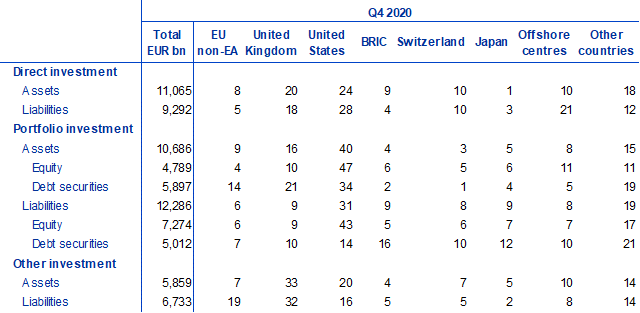
Source: ECB.
Notes: “Equity” comprises equity and investment fund shares. “EU non-EA” comprises EU Member States and EU institutions outside the euro area. The “BRIC” countries are Brazil, Russia, India and China. “Other countries” includes all countries and country groups not listed in the table as well as unallocated positions.
Data revisions
This statistical release incorporates revisions to data for the reference periods between the first quarter of 2017 and the third quarter of 2020. The revisions reflect revised national contributions to the euro area aggregates as a result of the incorporation of newly available information affecting in particular the data for direct investment and portfolio investment between the first and the third quarters of 2020.
Next releases
- monthly balance of payments: 19 April 2021 (reference data up to February 2021)
- quarterly balance of payments and international investment position: 5 July 2021 (reference data up to the first quarter of 2021)
For queries, please use the Statistical information request form.
Notes
- All data are neither seasonally nor working day-adjusted. Ratios to GDP (including in the charts) refer to four-quarter sums of non-seasonally and non-working day-adjusted GDP figures.
- Hyperlinks in this press release lead to data that may change with subsequent releases as a result of revisions.


